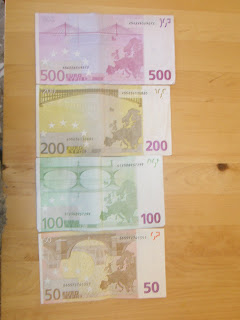I had to pay the girl's tutors the other day so I found myself with some euro bills that are not usually in my wallet! It thought you might enjoy seeing this lovely currency. I love the varying sizes and the bright colors. The fronts are decorated with fictional architectural drawings from various historical periods and the backs have the same fictional drawings of bridges. This representation of the architecture of a period makes sense once you think of the original 12 countries vying for representation of their particular landmark on the bills.
Fronts
 From top to bottom the representative styles on the fronts and backs of the bills are:
From top to bottom the representative styles on the fronts and backs of the bills are:500's: Modern 20th century
200's: 19th century art nouveau
100's: Baroque and Rococo
50's: Renaissance

All of the euro bills have six things in common:
- A depiction of the European Union flag
- The initials of the European Central Bank (ECB)
- A map of Europe
- The name "Euro" in Latin and Greek
- The signature of the current head of the ECB
- 12 stars representing the initial members
If you want to find out more about the Euro this is a good explanation: http://en.wikipedia.org/wiki/Euro_banknotes

Very educational....I've never actually looked at a bill of any currency that close-up.
ReplyDeleteThat's for the info.